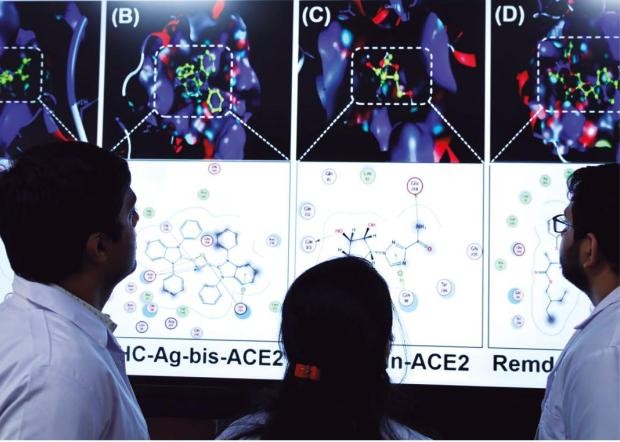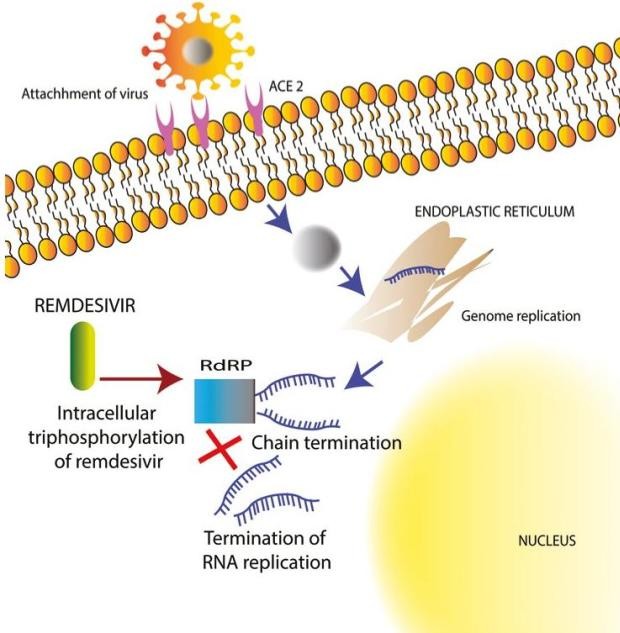[First published on 11 December 2020 ; Nature India Special Issue: COVID-19 Engineering Solutions]

Medical researchers review docking of the remdesvir drug molecule with SARS-CoV-2 viral protein. © RSC ADVANCES 2020
The use of artificial intelligence in the journey of new drug discovery has become integral to their development. Advances in computer modelling of biological processes, or ‘in-silico biology’ have revealed some of the crucial aspects of effective drug molecules with respect to their structure, functional groups, physiochemical nature, permeating ability, binding potential, bioavailability, receptor behaviour, and genetic interaction. In combating the spread of COVID-19, a broad range of strategies are being assisted with in silico validation, including small molecular drug repurposing, enzyme inhibition, and target drug delivery.
Among these, drug repurposing is a useful strategy to identify newer therapeutic applications. Repurposing hastens the drug development process, and has therefore received considerable research attention. Clinical investigations on repurposed small molecule drugs show promising response for COVID-19 therapy. Enzymes that play a role in the pathogenesis of SARS-CoV-2 virus include serine protease (TMPRSS2), cysteine protease (cathepsin B and L), RNA-dependent RNA polymerase (RdRp), 3-chymotrypsin-like protease (3CLpro), papain-like protease (PLpro), among others.
For most of the current US Food and Drug Administration (FDA) approved molecules under therapeutic regimen for COVID-19, the enzyme 3-chymotrypsin-like protease (3CLpro) has been identified as a promising drug target. Drugs including remdesivir, ertapenem, imipenem, and tenofovir reveal significant inhibitory interactions with high binding affinity on 3CLpro active sites. Therefore, these drugs, either alone or in combination, are under investigation for the management of COVID-19. Clinicians working to fight the COVID-19 pandemic are exploring repurposing existing drugs via in silico screening of viable candidates.
3CLpro renders high biological significance for the virus to synthesize its polyproteins emerging from open reading frames, the part of nucleic acid available for transcription. In addition, 3CLpro shares with the majority of human coronaviruses a sequential homology with respect to its structural and functional groups. It should be noted that 3CLpro is involved in cleaving 11 prominent sites to yield 16 non-structural proteins (NSP). Hence, targeting 3CLpro with novel enzyme inhibitors appears to be an ideal choice for researchers to minimize the viral replication time. Residual amino acids (His 41, Phe 140, Gly 143, Cys 144, Cys 145, His 163, Glu 166, His 172) spread across the catalytic domain (I & II) of the enzyme seeks the attention of the cleavage process. The challenge therefore is to engage all the active sites involved in mediating the production of NSPs to alter the sequence of replication.
Recently, remdesivir, an investigational small molecule entered the frame for therapeutic management of COVID-19. Immunologically, remdisivir has proven anti-viral efficacy against a spectrum of RNA viruses that includes SARS-CoV, MERS-CoV, Ebola virus, Nipah virus and other strains of bat coronaviruses that are capable of infecting human respiratory epithelial cells. Hence, it was believed that treatment with remdisivir offered promising therapeutic benefits to the patients with COVID-19.

Medical researchers review docking of the remdesvir drug molecule with SARS-CoV-2 viral protein. © RSC ADVANCES 2020
Remdisivir gained attention due to its diversified mechanism of action. Research suggests that remdisivir acts as nucleoside analogue and inhibits the enzyme RdRp (RNA-dependent RNA polymerase), limiting the replication of SARS-CoV-2 virus in the host cell. Although remdisivir was expected to be beneficial for a majority of patients, it still requires crucial validation on whether its pharmacology against multiple drug targets can be extended.
Apart from RdRp and 3CLpro, another enzyme, trans membrane serine protease 2 (TMPRSS2), holds interest for researchers as it primes the receptor binding domain of the viral S protein and is involved in cleavage of S1-S2 bonds to set the virus free from angiotensin-converting enzyme 2 (ACE2) after gaining entry inside the cell. Such proteases significantly help in viral membrane fusion and release of antigenic RNA into the host cell cytoplasm.
Studies further reveal that the oral pancreatitis drug camostat mesilate is active by effectively blocking the production of inflammatory mediators like monocyte chemoattractant protein-1 (MCP-1) and tumor necrosis factor-α (TNF-α). Hence, combination therapy may render some more convincing recovery rates in COVID-19 patients than monotherapy. Conjugating camostat mesilate with remdesivir is a novel strategy that may inhibit the bioactive enzymes such as serine protease, RdRp and 3CLpro which in turn restrict the viral entry and suppress the replication mechanisms.
Drug repurposing is a necessary approach to discover new solutions.
The authors are from the Centre for Laboratory Animal Technology and Research, Sathyabama Institute of Science and Technology in Chennai.
